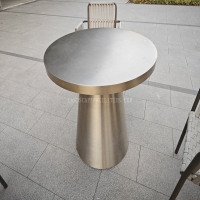Welcome to the website for landscape facilities products and knowledge.
What are the most innovative materials considered but not used in the table’s production?
The world of furniture design constantly flirts with material innovation, yet many groundbreaking substances never make it past the prototype stage for table production. While traditional materials like wood, glass, and metal dominate the market, several extraordinary alternatives have been seriously considered by designers and manufacturers. These materials promised to revolutionize how we perceive and interact with tables, yet they remain largely unused in commercial production.
One of the most fascinating materials considered was self-healing concrete. This innovative substance contains special bacteria that activate when cracks form, effectively filling gaps with limestone. For tables, this would mean surfaces that could repair minor scratches and damage automatically, potentially lasting decades without visible wear. However, the high production costs and significant weight limitations prevented its practical implementation in table manufacturing.
Transparent wood emerged as another promising candidate that captured designers' imaginations. Created by removing lignin from natural wood and replacing it with polymer, this material offers the warmth of wood with the transparency of glass. Tables made from transparent wood would provide unique aesthetic appeal while maintaining structural integrity. Unfortunately, the complex manufacturing process and vulnerability to UV degradation made mass production economically unfeasible.
Graphene composites presented perhaps the most exciting possibility - tables that could be both incredibly thin and exceptionally strong. With conductivity properties, graphene-enabled tables could potentially incorporate seamless charging capabilities and interactive surfaces. The prohibitive cost of producing high-quality graphene in large sheets, along with challenges in joining pieces without compromising integrity, kept this material in the realm of conceptual designs.
Mycelium, the root structure of mushrooms, offered an eco-friendly alternative that fascinated sustainable designers. Grown into specific shapes, mycelium-based tables would be completely biodegradable and have a negative carbon footprint. While successfully used for smaller items and packaging, the structural limitations and relatively short lifespan prevented mycelium from becoming a viable table material.
Recycled ocean plastics represented another noble endeavor that struggled to reach production lines. While prototypes demonstrated the technical feasibility of creating table surfaces from recovered plastic waste, inconsistencies in material quality and color, coupled with processing challenges, made standardized manufacturing difficult. The innovation highlighted environmental concerns but couldn't overcome practical production hurdles.
These materials, while technologically impressive, shared common barriers to adoption: cost-effectiveness, manufacturing scalability, and consumer acceptance. They continue to inspire designers and represent the cutting edge of material science, serving as reminders that innovation often precedes practicality in the evolution of furniture design. As technology advances, perhaps future iterations will overcome these limitations and transform how we produce and experience everyday objects like tables.
Related search:

Recommendation
Outdoor Metal Table - Classic Outdoor Furniture, Stainless Steel Table, Durable and Reliable